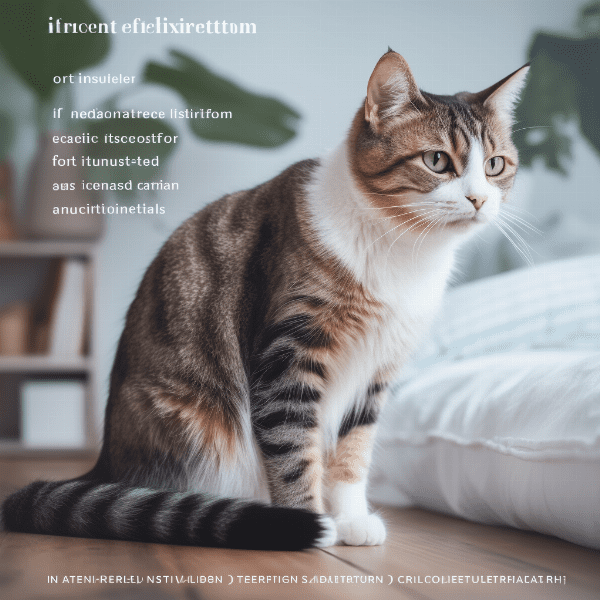Table of Contents
- Understanding Feline Infectious Peritonitis (FIP)
- Diagnosing FIP in Cats
- Treatment Options for FIP
- Medications Used in FIP Treatment
- Supportive Care for FIP Cats
- Managing FIP in Multi-Cat Households
- Preventing the Spread of FIP
- Monitoring the Progress of FIP Treatment
- Coping with the Loss of an FIP Cat
- Research and Future Developments in FIP Treatment.
Understanding Feline Infectious Peritonitis (FIP)
Feline Infectious Peritonitis (FIP) is a fatal and highly contagious disease in cats caused by a coronavirus. The virus can mutate within the cat’s body, leading to the development of FIP. The disease is more commonly seen in cats under the age of two, and those with weak immune systems are at higher risk of contracting the virus.
How FIP Spreads
FIP spreads through contact with the bodily fluids of infected cats. The virus can be found in the saliva, urine, and feces of infected cats. Cats can contract the virus through sharing food and water bowls, litter boxes, or through direct contact with an infected cat.
Types of FIP
There are two types of FIP: effusive and non-effusive. Effusive FIP is characterized by the accumulation of fluid in the abdominal cavity or chest, while non-effusive FIP is characterized by the formation of granulomas in various organs of the body.
FIP Diagnosis
FIP can be challenging to diagnose, as the symptoms can be similar to other diseases. A diagnosis of FIP is usually made based on a combination of clinical signs, blood tests, and fluid analysis. In some cases, a biopsy may be necessary to confirm the diagnosis.
Conclusion
FIP is a serious and often fatal disease that affects cats. The virus that causes FIP is highly contagious, and it is important to take steps to prevent the spread of the disease. If you suspect that your cat may have FIP, it is essential to seek veterinary care immediately to ensure the best possible outcome.
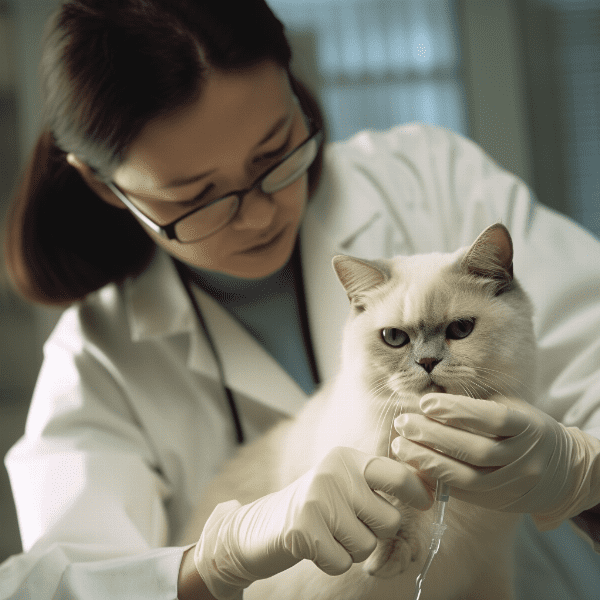
Diagnosing FIP in Cats
Diagnosing Feline Infectious Peritonitis (FIP) in cats can be challenging, as the disease can present with a wide range of symptoms that are similar to other illnesses. However, early detection and diagnosis of FIP can significantly improve the chances of successful treatment and recovery.
Clinical Signs
The clinical signs of FIP can vary depending on the stage and type of the disease. Common symptoms include fever, weight loss, loss of appetite, and lethargy. In some cases, cats may also experience abdominal swelling or neurological symptoms, such as seizures or difficulty walking.
Biopsy
In some cases, a biopsy may be necessary to confirm a diagnosis of FIP. This involves taking a small sample of tissue from an affected organ and examining it under a microscope. Biopsies are usually only performed if other diagnostic tests have been inconclusive.
Conclusion
Diagnosing FIP in cats can be challenging, but early detection and diagnosis are crucial for successful treatment and recovery. If you suspect that your cat may have FIP, it is essential to seek veterinary care immediately. Your veterinarian can perform a variety of tests to help diagnose the disease and develop an appropriate treatment plan.
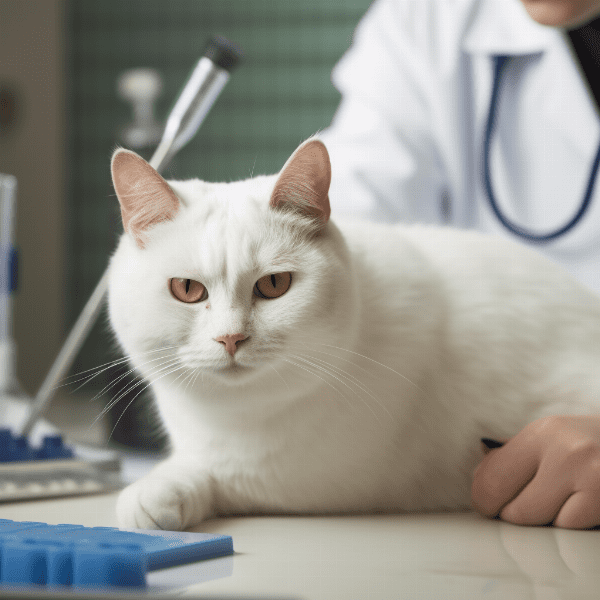
Treatment Options for FIP
Feline Infectious Peritonitis (FIP) is a challenging disease to treat, and there is currently no known cure. However, there are several treatment options available that can help manage the symptoms and prolong the cat’s life.
Supportive Care
Supportive care is an essential component of FIP treatment. This involves providing the cat with a comfortable and stress-free environment, as well as proper nutrition and hydration. In some cases, a feeding tube may be necessary to ensure that the cat is receiving adequate nutrition.
Medications
Several medications can be used to manage the symptoms of FIP. Corticosteroids can help reduce inflammation, while immunosuppressive drugs can help slow the progression of the disease. Antiviral drugs, such as protease inhibitors, have also been used with some success in treating FIP.
Palliative Care
In cases where the cat’s condition is advanced, palliative care may be the best option. This involves managing the cat’s symptoms and providing supportive care to improve their quality of life. Euthanasia may also be considered if the cat’s condition is causing them significant pain or suffering.
Conclusion
FIP is a challenging disease to treat, but there are several options available that can help manage the symptoms and prolong the cat’s life. Supportive care, medications, and experimental treatments can all play a role in FIP treatment. If you have a cat with FIP, it is essential to work closely with your veterinarian to develop an appropriate treatment plan that meets their specific needs.
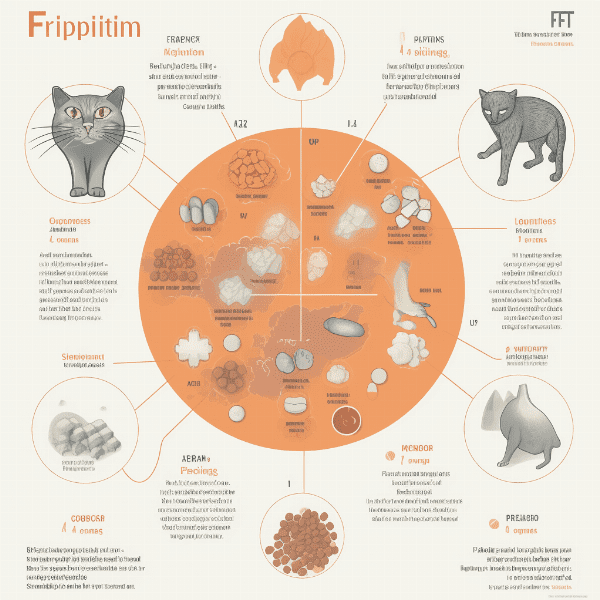
Medications Used in FIP Treatment
While there is currently no known cure for Feline Infectious Peritonitis (FIP), several medications can be used to manage the symptoms and slow the progression of the disease.
Corticosteroids
Corticosteroids are a type of medication commonly used in FIP treatment. They work by reducing inflammation in the body, which can help relieve many of the symptoms associated with the disease. Corticosteroids are often used in conjunction with other medications, such as immunosuppressive drugs.
Immunosuppressive Drugs
Immunosuppressive drugs, such as cyclosporine and chlorambucil, are sometimes used in FIP treatment. These medications work by suppressing the immune system, which can help slow the progression of the disease. However, they can also increase the risk of infections and other complications.
Antiviral Drugs
Antiviral drugs, such as protease inhibitors, have been used with some success in treating FIP. These medications work by targeting the virus directly and preventing it from replicating. However, antiviral drugs are not effective in all cases, and they can be expensive and difficult to obtain.
Conclusion
Medications play an essential role in FIP treatment, but there is currently no known cure for the disease. Corticosteroids and immunosuppressive drugs can help manage the symptoms and slow the progression of the disease. Antiviral drugs and experimental treatments may also be effective in some cases. If you have a cat with FIP, it is essential to work closely with your veterinarian to develop an appropriate treatment plan that meets their specific needs.

Supportive Care for FIP Cats
Supportive care is an essential component of Feline Infectious Peritonitis (FIP) treatment. Providing your cat with proper nutrition, hydration, and a comfortable and stress-free environment can help manage their symptoms and improve their quality of life.
Nutrition and Hydration
Cats with FIP may have a reduced appetite, making it difficult for them to consume enough food and water to maintain their health. In some cases, a feeding tube may be necessary to ensure that the cat is receiving adequate nutrition. It is also essential to provide fresh water at all times and encourage your cat to drink regularly.
Comfortable Environment
FIP cats should be provided with a comfortable and stress-free environment. This may involve providing a warm and soft place to rest, minimizing exposure to loud noises and bright lights, and providing plenty of toys and stimulation to keep the cat entertained.
Pain Management
FIP can be a painful disease, and pain management is an essential aspect of supportive care. Your veterinarian may prescribe pain medications, such as opioids or non-steroidal anti-inflammatory drugs (NSAIDs), to help manage your cat’s pain.
Monitoring and Treatment of Secondary Infections
Cats with FIP are at higher risk of developing secondary infections, such as bacterial infections or urinary tract infections. It is essential to monitor your cat closely for signs of infection and seek veterinary care if necessary. Antibiotics or other medications may be necessary to treat secondary infections.
Conclusion
Supportive care is a crucial aspect of FIP treatment, as there is currently no known cure for the disease. Providing your cat with proper nutrition and hydration, a comfortable environment, pain management, and monitoring and treatment of secondary infections can all help manage the symptoms of FIP and improve your cat’s quality of life. If you have a cat with FIP, it is essential to work closely with your veterinarian to develop an appropriate supportive care plan that meets their specific needs.

Managing FIP in Multi-Cat Households
Feline Infectious Peritonitis (FIP) is a highly contagious disease that can quickly spread through a multi-cat household. Managing FIP in a multi-cat household requires a combination of preventive measures and careful management of infected cats.
Isolating Infected Cats
Infected cats should be isolated from other cats in the household to prevent the spread of the disease. This may involve keeping them in a separate room or area of the house, with their own food, water, and litter box. Infected cats should not be allowed to interact with healthy cats.
Monitoring for Symptoms
It is essential to monitor all cats in a multi-cat household for symptoms of FIP. Cats with a weakened immune system or those under two years old are at higher risk of contracting the disease. Any cats showing symptoms of FIP should be immediately isolated and taken to the veterinarian for diagnosis and treatment.
Conclusion
Managing FIP in a multi-cat household requires careful planning and management to prevent the spread of the disease. Isolating infected cats, preventing direct contact, maintaining good hygiene, and monitoring for symptoms are all essential for managing FIP in a multi-cat household. If you have a cat with FIP in a multi-cat household, it is essential to work closely with your veterinarian to develop an appropriate management plan that meets the specific needs of your cats.
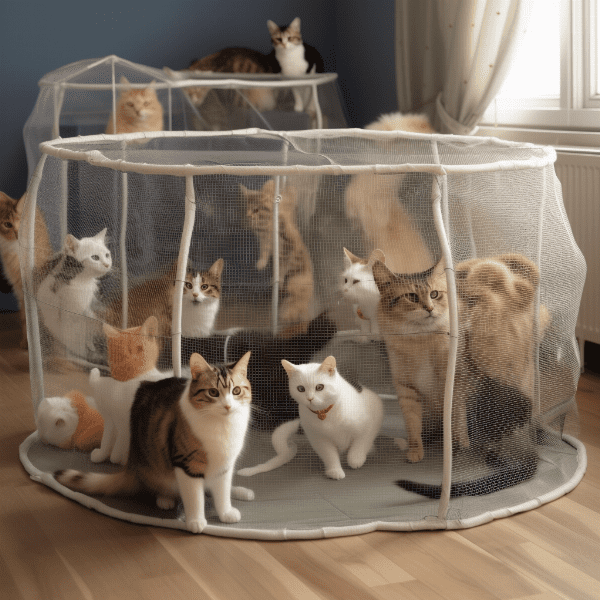
Preventing the Spread of FIP
Preventing the spread of Feline Infectious Peritonitis (FIP) is essential to protect the health of cats and prevent the disease from spreading through a community or household. There are several steps that can be taken to prevent the spread of FIP.
Vaccination
Currently, there is no commercially available vaccine for FIP. However, there are several experimental vaccines in development that may offer some protection against the disease in the future.
Good Hygiene
Good hygiene is essential for preventing the spread of FIP. This includes regular cleaning and disinfecting of litter boxes, food and water bowls, and bedding. It is also important to wash your hands thoroughly after handling cats, particularly if they have been diagnosed with FIP.
Isolation
Isolating infected cats is essential for preventing the spread of FIP. Infected cats should be kept in a separate room or area of the house, with their own food, water, and litter box. They should not be allowed to interact with healthy cats.
Conclusion
Preventing the spread of FIP is essential to protect the health of cats and prevent the disease from spreading through a community or household. Good hygiene, isolation, preventing direct contact, and vaccination (when available) are all essential steps in preventing the spread of FIP. If you have a cat with FIP, it is important to work closely with your veterinarian to develop an appropriate management plan that meets the specific needs of your cat and helps prevent the spread of the disease.
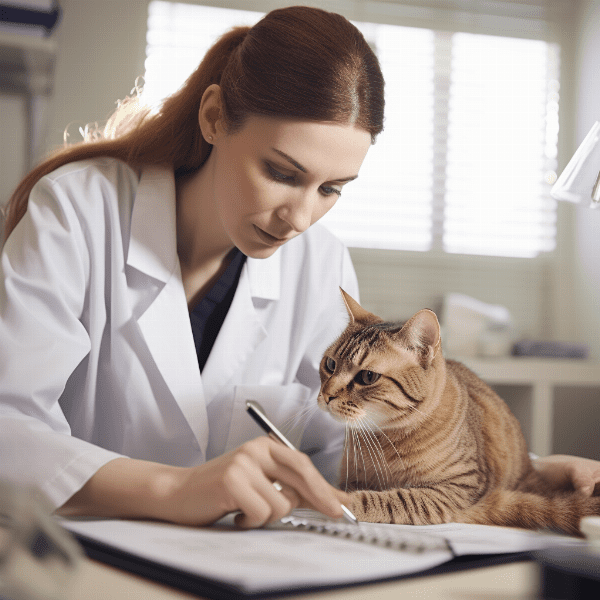
Monitoring the Progress of FIP Treatment
Monitoring the progress of Feline Infectious Peritonitis (FIP) treatment is essential to ensure that the treatment is effective and to make any necessary adjustments to the treatment plan. There are several ways to monitor the progress of FIP treatment.
Regular Veterinary Check-ups
Regular veterinary check-ups are essential for monitoring the progress of FIP treatment. Your veterinarian will be able to assess your cat’s overall health and monitor any changes in their condition. They may also perform diagnostic tests, such as blood tests or fluid analysis, to determine the effectiveness of the treatment.
Monitoring Symptoms
Monitoring your cat’s symptoms is an important part of monitoring the progress of FIP treatment. Keep track of any changes in appetite, weight, behavior, or other symptoms, and report them to your veterinarian. This will help your veterinarian make any necessary adjustments to the treatment plan.
Blood Tests
Blood tests can be used to monitor the effectiveness of FIP treatment. A complete blood count (CBC) can reveal changes in the white blood cell count, which may be indicative of the disease. Blood chemistry panels can also help identify changes in liver and kidney function, which may be related to FIP.
Fluid Analysis
Fluid analysis can also be used to monitor the progress of FIP treatment. This involves collecting a sample of fluid from the abdomen or chest and examining it for the presence of the virus. In cases of effusive FIP, the fluid will often appear yellow and cloudy and contain high levels of protein.
Conclusion
Monitoring the progress of FIP treatment is essential to ensure that the treatment is effective and to make any necessary adjustments to the treatment plan. Regular veterinary check-ups, monitoring symptoms, blood tests, and fluid analysis can all help monitor the progress of FIP treatment. If you have a cat with FIP, it is essential to work closely with your veterinarian to develop an appropriate treatment plan and to monitor the progress of the treatment closely.

Coping with the Loss of an FIP Cat
Losing a beloved pet to Feline Infectious Peritonitis (FIP) can be a difficult and emotional experience. Coping with the loss of an FIP cat requires time, patience, and support from friends, family, and veterinary professionals.
Allow Yourself to Grieve
Allow yourself to grieve the loss of your cat. Everyone copes with loss differently, and it is essential to give yourself time to process your emotions. Don’t be afraid to seek support from friends, family, or a professional counselor if you need it.
Remember Your Cat
Remembering your cat can help you cope with their loss. Consider creating a memorial, such as a photo album, scrapbook, or shadow box, to honor their memory. You may also want to make a donation in their memory to a cat-related charity or organization.
Seek Support
Seeking support from others can be helpful in coping with the loss of an FIP cat. Consider joining a support group for pet owners who have lost a beloved animal. Talking to other pet owners who have gone through a similar experience can provide comfort and understanding.
Take Care of Yourself
Coping with the loss of an FIP cat can be emotionally and physically draining. It is essential to take care of yourself during this difficult time. Make sure you are eating well, getting enough rest, and engaging in activities that bring you joy.
Conclusion
Losing a cat to FIP can be a challenging and emotional experience. Coping with the loss requires time, patience, and support from friends, family, and veterinary professionals. Allow yourself to grieve, remember your cat, seek support, and take care of yourself during this difficult time. If you are struggling to cope with the loss of your FIP cat, don’t hesitate to seek professional help.

Research and Future Developments in FIP Treatment.
Feline Infectious Peritonitis (FIP) is a complex and challenging disease to treat, and there is currently no known cure. However, ongoing research and development offer hope for future advancements in FIP treatment.
Current Research
There are several ongoing research projects exploring the mechanisms of FIP and potential treatments. One area of focus is developing a better understanding of the virus and how it interacts with the cat’s immune system. Other research projects are investigating the use of antiviral drugs, immunotherapy, and gene therapy as potential treatments.
Experimental Treatments
Several experimental treatments have shown promise in treating FIP. These include the use of protease inhibitors, which target the virus’s ability to replicate, and the use of monoclonal antibodies, which target the virus’s protein spikes. However, these treatments are still in the experimental stage and have not yet been approved for widespread use.
Future Developments
The development of a vaccine for FIP is a significant area of focus in future developments. Several experimental vaccines are currently in development and have shown promise in clinical trials. Additionally, ongoing research into the virus’s mechanisms and potential treatments may lead to new and innovative therapies for FIP.
Conclusion
FIP is a challenging disease to treat, and there is currently no known cure. However, ongoing research and development offer hope for future advancements in FIP treatment. Current research projects are exploring the virus’s mechanisms and potential treatments, and experimental treatments and vaccines have shown promise in clinical trials. If you have a cat with FIP, it is essential to work closely with your veterinarian to develop an appropriate treatment plan and to stay informed about new developments in FIP treatment.



